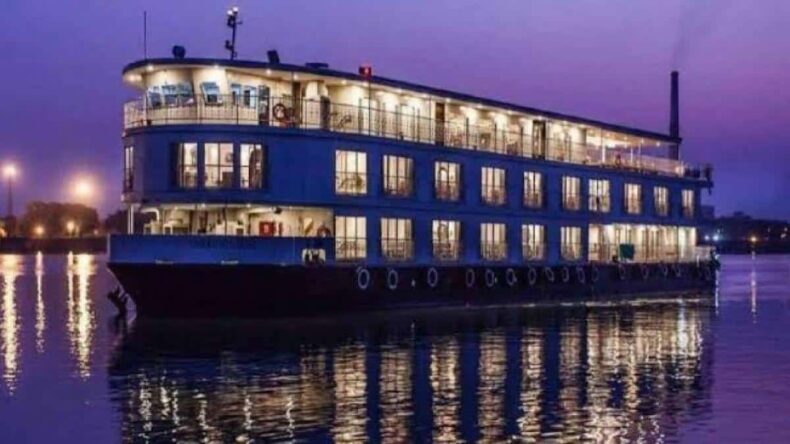India’s new age of tourism commences with the announcement of Prime Minister Narendra Modi’s ‘World’s longest river cruise’.
The 18-suite, three-deck MV Ganga Vilas is the newest endeavor in a government-promoted trend of cruise tourism in India. Modi welcomed the Ganges cruise industry as a “landmark occasion”.
The MV Ganga Vilas sailboat has a length of 62 meters, a width of 12 meters, and a draught of 1.4 meters. All 18 apartments include floor-to-ceiling windows that provide river views around the clock.
The cruise exudes luxury and costs ₹50 to 55 Lakhs ($65,200 approx.) per passenger.

The exquisite journey would span 51 days and cover 3,200 kilometers from Dhaka, Bangladesh to Dibrugarh, Assam over 27 river systems.
Up to 50 tourist destinations, including world heritage sites, national parks, river ghats, and important towns such as Patna in Bihar, Sahibganj in Jharkhand, Kolkata in West Bengal, Dhaka in Bangladesh, and Guwahati in Assam, would be visited by the customers.
MV GANGA VILAS VS SUSTAINIBILITY
While the new age is estimated to bring profit and growth to India’s revenue as well as the tourist industry, is it at the cost of the continent’s marine biology?
Environmentalists and activists argue that the increase in excursions might do irreparable harm to the Ganges river dolphin’s habitat (Platanista gangetica).

“The cruises are a dangerous proposition in addition to all the existing risks for the dolphins,” said Ravindra Kumar Sinha, Padma Shri awarded Indian biologist and environmentalist.
The number of these protected species has increased in the past few years but many fear that the cruise will undo this and create an even more hazardous environment.
The MV Ganga Vilas will cruise via the town of Kaithi, 30 kilometers from Varanasi at the junction of the Ganges and Gomti Rivers, where the deep water and moderate currents provide a safe home for the endangered dolphin. In October, wildlife authorities discovered a pod with calves and estimated that there were 35 to 39 dolphins in the region.

It is one of a handful of protected cetacean habitats along the cruise’s route, including the Bihar Vikramshila Gangetic Dolphin Sanctuary.
Platanista gangetica is one of the two species of freshwater dolphins in south Asia, together with Platanista minor or the Indus river dolphin, which is located in Pakistan and the Beas River in northern India. Threats to the Ganges river dolphin include water contamination, increasing water extraction, and poaching.
According to the cruise director, Mr. Raj Singh, this trip has a Sewage Treatment Plant to prevent sewage from entering the Ganges, as well as a filtration plant that filters Ganga water for bathing and other uses.
An effort towards the tourism industry is hand in hand with the investment of over ₹1000 crores in inland waterways projects made by the current government under PM Modi.
Official statements lead us to believe that this is only the iceberg of the future India wishes to aim at and achieve for the tourism industry.
What environmentalists across the world hope for, is a definition of development that includes sustainability, instead of MV Ganga Vilas vs the Ganges dolphin.













